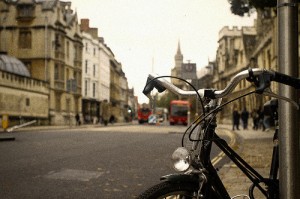 Renowned American expert of etiquette Emily Post once said “Whenever two people come together and their behavior affects one another, you have etiquette.” Nowhere is this more true than the road, where hundreds of people are interacting on every street, and their actions can literally have life or death consequences for other people. A little education combined with a little patience can go a long way for making everyone’s commutes safer and easier. Etiquette between cyclists and motorists is especially important, because even a minor collision can be deadly for exposed bike riders. Some of the advice applies to both parties, but let’s take a look at specifics first.
Renowned American expert of etiquette Emily Post once said “Whenever two people come together and their behavior affects one another, you have etiquette.” Nowhere is this more true than the road, where hundreds of people are interacting on every street, and their actions can literally have life or death consequences for other people. A little education combined with a little patience can go a long way for making everyone’s commutes safer and easier. Etiquette between cyclists and motorists is especially important, because even a minor collision can be deadly for exposed bike riders. Some of the advice applies to both parties, but let’s take a look at specifics first.
Etiquette for Cyclists
- Obey the laws: The one that we’ve touched on again and again is following traffic laws. If you want the protection that comes from being treated like a vehicle, then you need to act like one. Running through stop lights or signs are ticketable, dangerous, and just as illegal as if you were driving. Drivers will not respect you if you are flaunting laws.
- Be Vocal: Get a bell or use your voice. When passing people let them know you are coming from behind. This applies to pedestrians or stationary vehicles. When they let you pass, wave politely to let them know you appreciate it. You should always be very clear in communicating your intentions. Being vocal includes using hand signals so everyone knows where you are headed.
- Eye contact: Just because you see the cars and know what they should be doing, doesn’t mean they see you or are going to do what they should. Your best defense for this is to make sure you make eye contact with the driver before assuming you have the right of way. A little head nod could save you from a collision or worse.
Etiquette for Motorists
- Look around: Most motorists assume that when they are turning right, they don’t need to check their right blind spot. That is where the bikers are going to be, so make sure to use your blinker and always look.
- Use your lane and we’ll use ours: The bike lane is not for passing, or driving, or turning right. The bike lane is for bikes. It helps keep bikers safe and makes more room for cars. If it’s there cyclists will love to use it, but only if your car isn’t in it. If you really want to ride in the bike lane, grab a cycle and we’ll see you out there.
- Give a wide berth: Bikes are probably going to be slower than cars, but that doesn’t mean you have to pass them immediately. If you can’t give them at least three feet of clearance, it is actually illegal to pass them. If you can, change lanes completely or just give them as much room as you can manage.
Etiquette for Both
- Be predictable: This is the best advice for both parties. The people that forget they are turning right until one second before and change two lanes to get there are dangerous for everyone. Cyclists that swerve back and forth or try to pop a wheelie are idiotic and just as dangerous. Follow the laws and do what you’re supposed to do. Look around and anticipate what others will be doing and what you should be doing.
- Be patient: We’ve covered some of this already, but for motorists, if it isn’t safe to pass immediately, be patient. For cyclists, if you think a driver hasn’t seen you, then don’t be in rush to blow through that four-way stop or green light. Make sure that those people who are trying to squeeze through the light four seconds after it turned red are all done.
- Be observant: Don’t get busy texting or changing the radio or switching tracks on your ipod. Keep eyes up and both hands on the steering wheel or handlebars. Not only should you know what is coming, but you should keep an eye on what is going on behind you. Motorists, if you have parked make sure to look for cyclists coming up before opening your door. This is a very common cause for cycling injuries.
Basically, everyone needs to step up their game to make the road safer. We need to be just a little more patient, and a little more observant. It won’t add much if any time to your travel, and even if it could save you two minutes, it’s not worth the risk of seriously injuring someone.
Photo courtesy of Samuel David Rhinehart.
